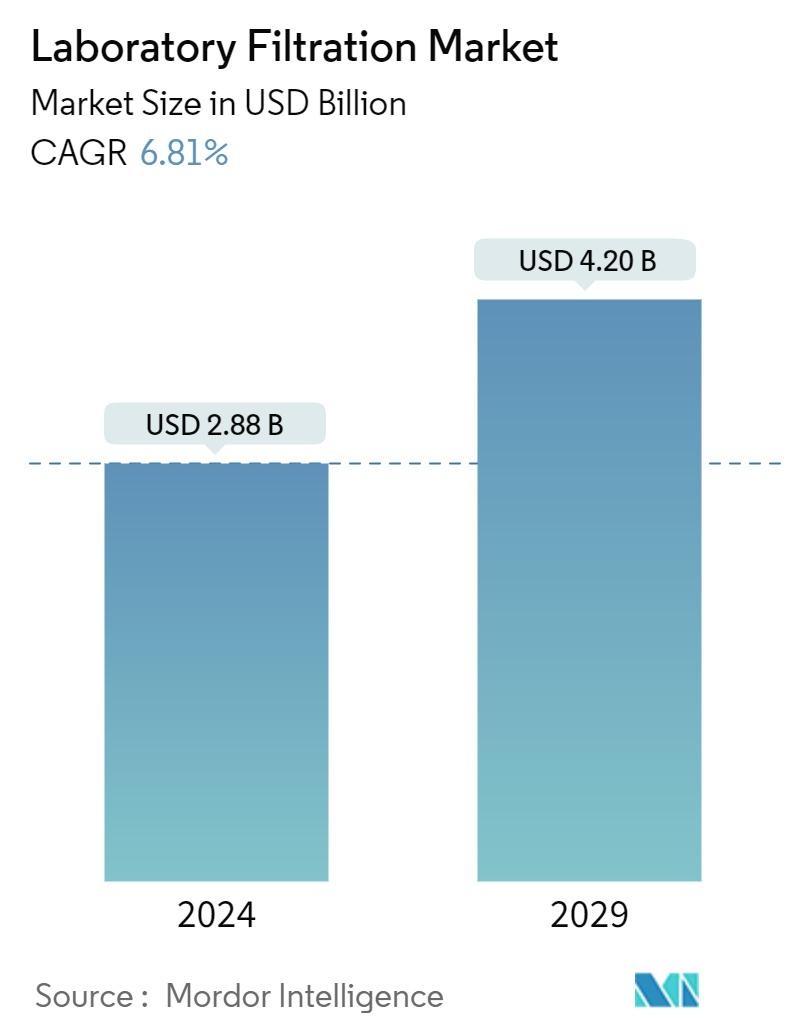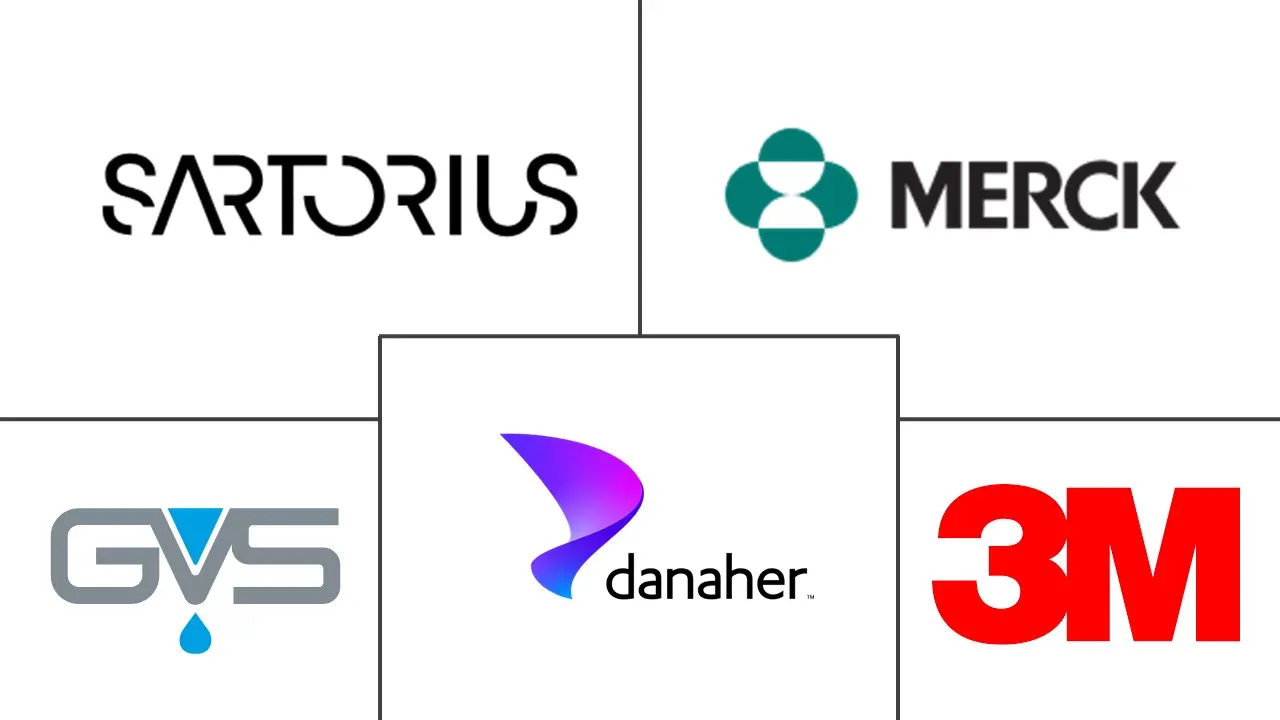Market Size of Laboratory Filtration Industry

| Study Period | 2019 - 2029 |
| Market Size (2024) | USD 2.88 Billion |
| Market Size (2029) | USD 4.20 Billion |
| CAGR (2024 - 2029) | 6.81 % |
| Fastest Growing Market | Asia-Pacific |
| Largest Market | North America |
| Market Concentration | Medium |
Major Players
*Disclaimer: Major Players sorted in no particular order |
Laboratory Filtration Market Analysis
The Laboratory Filtration Market size is estimated at USD 2.88 billion in 2024, and is expected to reach USD 4.20 billion by 2029, at a CAGR of 6.81% during the forecast period (2024-2029).
- The major drivers for the laboratory filtration market are technological advancements in laboratory filtration and the increase in research and development spending by the biotechnology industries. These advancements significantly enhance the laboratory filtration market by offering improved efficiency, accuracy, and capabilities, empowering researchers and contributing to groundbreaking discoveries across various scientific fields.
- Automation streamlines workflows, reduces human error, and improves data consistency. Additionally, integration of the filtration system with other lab equipment enhances overall lab efficiency. For instance, in September 2022, Pall Corporation launched three new Allegro Connect Systems, including systems supporting depth filtration, virus filtration, bulk fill of drug substances, and a buffer management system to simplify manufacturing workflows.
- Biotech companies heavily rely on filtration throughout the biopharmaceutical production process. This includes sterilizing culture media and buffers used to grow cells, separating cells from the product after fermentation, purifying the desired biopharmaceutical product, and filtering the final product to ensure sterility and remove contaminants.
- The biotechnology industry's heavy reliance on filtration, coupled with its focus on research and development, creates a continuous demand for improved and innovative filtration solutions. For example, according to data published by the National Institute of Health, the United States spent over USD 8,604 million on research and development in the field of biotechnology. Therefore, considerable market growth is anticipated to fuel the forecast period, driven by such technological advancements.
- Thus, technological advancements in laboratory filtration and the growth in research and development activities within the biotechnology industries are expected to drive the growth of the laboratory filtration market. However, the reuse of sterilizing-grade filters and the high cost of specialized filters are likely to impede market growth over the forecast period.
Laboratory Filtration Industry Segmentation
Laboratory filtration is the process of separating solid particles from liquids or gases in a lab. It is crucial for purification and separation purposes in research, quality control, and various industries.
The laboratory filtration market is segmented by technology, product, and geography. By technology, the market is segmented into microfiltration, ultrafiltration, reverse osmosis, vacuum filtration, and nanofiltration. By product, the market is segmented into filtration media, filtration assemblies, and filtration accessories. By filtration media, the market is segmented into membrane filters, filter papers, filtration microplates, syringeless filters, syringe ilters, and capsule filters. By filtration assemblies, the market is segmented into microfiltration assemblies, ultrafiltration assemblies, vacuum filtration assemblies, reverse osmosis assemblies, and nanofiltration assemblies. By geography, the market is segmented into North America, Europe, Asia-Pacific, Middle East and Africa, and South America. The market report also covers the estimated market sizes and trends for 17 different countries across major regions, globally.
The report offers the value (USD) for the above segments.
| By Technology | |
| Microfiltration | |
| Ultrafiltration | |
| Reverse Osmosis | |
| Vacuum Filtration | |
| Nanofiltration |
| By Product | ||||||||
| ||||||||
| ||||||||
| Filtration Accessories |
| Geography | ||||||||
| ||||||||
| ||||||||
| ||||||||
| ||||||||
|
Laboratory Filtration Market Size Summary
The laboratory filtration market is poised for significant growth, driven by the increasing demand for vaccine development and manufacturing, particularly in the wake of the COVID-19 pandemic. The pandemic has accelerated the adoption of various filtration techniques essential for vaccine production, thereby boosting the demand for laboratory filtration equipment. This trend is expected to continue as initiatives to enhance vaccination rates, especially among newborns and children, gain momentum. The market is further supported by the introduction of innovative technologies and increased investments in research and development, which are enhancing the efficiency and applicability of laboratory filtration processes. Ultrafiltration, in particular, is gaining traction due to its advantages in protein purification and vaccine manufacturing, offering high product throughput and rapid results.
North America is anticipated to experience substantial growth in the laboratory filtration market, fueled by robust research activities and significant investments in medical and health R&D. The region's market expansion is supported by the presence of key industry players, strategic partnerships, and new product launches, which are driving innovation and enhancing market competitiveness. The competitive landscape is characterized by the activities of major companies such as 3M Company, Merck KGaA, and Danaher Corporation, among others, who are actively expanding their filtration portfolios through acquisitions and collaborations. These developments are expected to create new opportunities for both established and emerging players in the market, contributing to its overall growth trajectory over the forecast period.
Laboratory Filtration Market Size - Table of Contents
-
1. MARKET DYNAMICS
-
1.1 Market Overview
-
1.2 Market Drivers
-
1.2.1 Technological Advancements in Laboratory Filtration
-
1.2.2 Rise in Research and Development Spending by the Biotechnology Industries
-
-
1.3 Market Restraints
-
1.3.1 Reuse of Sterilizing-grade Filters and High Cost of Specialized Filters
-
-
1.4 Porter's Five Forces Analysis
-
1.4.1 Threat of New Entrants
-
1.4.2 Bargaining Power of Buyers/Consumers
-
1.4.3 Bargaining Power of Suppliers
-
1.4.4 Threat of Substitute Products and Services
-
1.4.5 Intensity of Competitive Rivalry
-
-
-
2. MARKET SEGMENTATION (Market Size by Value - USD)
-
2.1 By Technology
-
2.1.1 Microfiltration
-
2.1.2 Ultrafiltration
-
2.1.3 Reverse Osmosis
-
2.1.4 Vacuum Filtration
-
2.1.5 Nanofiltration
-
-
2.2 By Product
-
2.2.1 Filtration Media
-
2.2.1.1 Membrane Filters
-
2.2.1.2 Filter Papers
-
2.2.1.3 Filtration Microplates
-
2.2.1.4 Syringeless Filters
-
2.2.1.5 Syringe Filters
-
2.2.1.6 Capsule Filters
-
-
2.2.2 Filtration Assemblies
-
2.2.2.1 Microfiltration Assemblies
-
2.2.2.2 Ultrafiltration Assemblies
-
2.2.2.3 Vacuum Filtration Assemblies
-
2.2.2.4 Reverse Osmosis Assemblies
-
2.2.2.5 Nanofiltration Assemblies
-
-
2.2.3 Filtration Accessories
-
-
2.3 Geography
-
2.3.1 North America
-
2.3.1.1 United States
-
2.3.1.2 Canada
-
2.3.1.3 Mexico
-
-
2.3.2 Europe
-
2.3.2.1 Germany
-
2.3.2.2 United Kingdom
-
2.3.2.3 France
-
2.3.2.4 Italy
-
2.3.2.5 Spain
-
2.3.2.6 Rest of Europe
-
-
2.3.3 Asia-Pacific
-
2.3.3.1 China
-
2.3.3.2 Japan
-
2.3.3.3 India
-
2.3.3.4 Australia
-
2.3.3.5 South Korea
-
2.3.3.6 Rest of Asia-Pacific
-
-
2.3.4 Middle East and Africa
-
2.3.4.1 GCC
-
2.3.4.2 South Africa
-
2.3.4.3 Rest of Middle East and Africa
-
-
2.3.5 South America
-
2.3.5.1 Brazil
-
2.3.5.2 Argentina
-
2.3.5.3 Rest of South America
-
-
-
Laboratory Filtration Market Size FAQs
How big is the Laboratory Filtration Market?
The Laboratory Filtration Market size is expected to reach USD 2.88 billion in 2024 and grow at a CAGR of 6.81% to reach USD 4.20 billion by 2029.
What is the current Laboratory Filtration Market size?
In 2024, the Laboratory Filtration Market size is expected to reach USD 2.88 billion.

